Category — Text
Melding the two T’s
I have used wikipedia to define some of the commonly held meanings of the words text and technology. I believe the melding of these two words demonstrates the interconnectedness of text and technologies and their significance in the 21st century. D. Ryan

September 16, 2009 2 Comments
Text is…by Tracy Gidinski
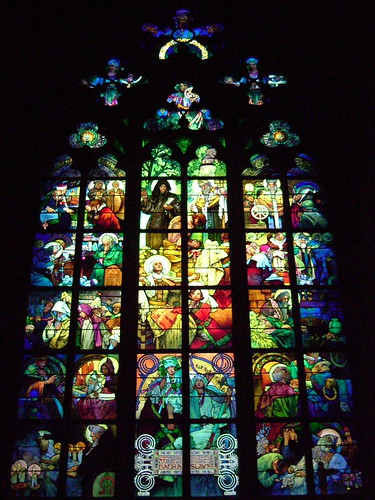
Prague – stained glass window, originally uploaded by thebevster.
This Mucha stained glass in St. Vitus’ Cathedral in Prague represents to me what text is. What I love about this stained glass is its modern take on a classic format. Instead of copying the style of the past when Mucha was asked to design it in the 1930’s, he wove history and the present day together to create something that represented both his history and his modern era. Likewise, text is the capturing of a culture at a given moment while simultaneously weaving in elements of that culture’s history.
Additionally, like Mucha’s stained glass techniques included modern technologies, making his images different than those of the past, new technologies add change and new shape to text.
Therefore, text and technology cannot be viewed as separate entities but as reflections of one another.
September 15, 2009 No Comments
…..TEXT….is….
Text is…. Images and words….. bound together by some pattern….. that is understandable by a community…… that transcends time……. until it is discovered by another culture and then is researched and analyzed……. Text is what we create…… when we weave together thoughts…… to share ideas with others……. to create rules….. to create escapes…….. Text is not just words…… not just ideas….. not just symbols with meanings…… Text can define who we are…. where we are going…. how we got there……This is my idea of text.
September 15, 2009 No Comments
Text is….. meaningful
“I was working on the proof of one of my poems all the morning, and took out a comma. In the afternoon I put it back again.”
Oscar Wilde
Much like the intentions within this quote, text can be meaningful in brevity while subtle nuances can make significant adjustments. The beauty of text is that is can be manipulated in so many ways and infinite possibilities are afforded to any who choose to play with letters and words. Text is the vehicle by which authors assign meaning; the artifact in which we immortalize thoughts and facts; the unspoken representation by which we speak. Text is our tangible fingerprint crafted in written language.
September 15, 2009 No Comments
What is text?
Since being made aware of the fact that the word text is contained in the words texture and textile and is defined as “woven words” in Module 1, I’m reminded of the song Tapestry by Carol King, that relates to the words textile and texture. In The first stanza, she compares her life experiences to a tapestry, which is a form of textile that has a rich texture. She says that she can see and feel the experiences in her life, but she can’t hold on to the experiences. Here are the lyrics of the first stanza of this song:
“My life has been a tapestry of rich and royal hue
An everlasting vision of the ever changing view
A wondrous woven magic in bits of blue and gold
A tapestry to feel and see, impossible to hold”
Carol king wove the words of the first stanza together to form text that began a very lyrically rich song.
September 15, 2009 1 Comment
What is Text?
Although we certainly do see and use text on computers and the internet, I wonder if there is something inherently flawed with using this way of viewing text with students. I don’t believe that the text excites students but that the computer that excites students.
A few short months ago I was teaching a primary summer school program. The program was designed for young learners to improve their English writing skills. I decided to have fun one class and have them create their own sentences using stamps. One thing that I noticed, apart from the activity getting really messy, was the excitement that the students had communicating their ideas onto paper using the stamps. There was something in the action of choosing a word, placing the stamp on the ink pad, and seeing their work that that engaged the students far more than a computer activity ever could.
Now is this text that the students created? I think that it is. The students printed their own work on paper, using letters and numbers. It did not matter if the text was coherent or not. Of course, is this the proper way to teach writing skills? However the students received an intriguing lesson and were able to create text manually in an old fashioned way that hopefully enforces the message that there is more than one way to create text.
September 15, 2009 1 Comment
Text is a Stimulant

In its most basic state, I see text as something designed to induce a state of mind both when text is created and when it is consumed. Marks are applied to a surface and visually consumed with the intent of inducing an awareness of something else apart from the awareness of the mark itself. That’s an amazing head trip.
Text stimulates us to see our minds reflected back into space and thus, compared to early primal humans, gives us this out of body experience of who we are. To early humans, consuming text would be like taking peyote buttons.
Reference:
Image uploaded by Arenamontanus on 11 Dec 08, 2.00PM PDT on Flickr. Modified by Drew Murphy.
September 15, 2009 1 Comment
Text, Technology, Orality….becomes residual…
Topics/Writing is a drag/ questions from the first module/ personal definitions of Text and Technology, Orality becomes Residual….more questions…
I think we have had an amazing discussion in terms of defining Text and Technology…and Orality… as pointed out in the cambridge session…. someone always objects to a new technology….

Socrates: Writing is ‘inhuman’
Writing, Socrates argues, is inhuman. It attempts to turn living thoughts dwelling in the human mind into mere objects in the physical world. By causing people to rely on what is written rather than what they are able to think, it weakens the powers of the mind and of memory. True knowledge can only emerge from a relationship between active human minds. And unlike a person, a text can’t respond to a question; it will just keep saying the same thing over and over again, no matter how often it is refuted.
What is Orality? When It becomes….Residual
‘Residual orality’ refers to thought and its verbal expression in cultures that have been exposed to writing and print, but have not fully ‘interiorized’ (in McLuhan’s term) the use of these technologies in their daily lives. As a culture interiorizes the technologies of literacy, the ‘oral residue’ diminishes.
[This information was Retrieved from Wiki Reference: Orality, Sept 14, 2009]
Questions from Module 1:
What is Text? Text to me is synonymous with writing, it also infers content and meaning, that is, text without meaning or letters that don’t form words, would not be “text” but rather just an assemblage of letters, of strokes on a page. Text is meaning, a codification of meaning, but the whole point of text for me is to communicate, communicate what? Communicate meaning.
What is Technology?: means everything that involves technique, that involves a tool, so a pen is a type of writing technology….and language is a kind or technology of orality…etc.
What, for example, does textile have to do with text? Texts are tapestries or weavings of words to create meaning… just as threads are used to create a pattern, letters are used to create a pattern that describes a word, which in turn describes or outlines a meaning….
In the hopes that a visual is in order here….and to layer that onto our discussion, of course all I come up is…more questions…such as…
How is meaning communicated visually?
….Some consider music the highest art form, but just how does music “speak” to us?
How do sounds through speech really communicate meaning?convey Emotion?
Okay I will let the picture do the rest of the speaking here….Barb
September 15, 2009 No Comments
Text – Definition
Beowulf
The beginning might not be the end. And that night
Grendel cam again, so set
On murder that no crime could ever be enough,
No savage assault quench his lust
For evil. Then each warrior tried
To escape him, searched for rest in different
Beds, as far from Herot as they could find,
Seeing how Grendel hunted when they slept.
Distance was safety; the only survivors
Were those who fled him. Hate had triumphed.
Author unknown
Line 134-143
Translated by Burton Raffel
Signet Classic – New American Library, 1963
For a representation of text my initial thought was Beowulf. For me, Beowulf is one of the ultimate representations of text. This epic poem has an unknown author and is thought to be one of the first documented texts in Anglo-Saxon history. Much debate surrounds this poem as it is thought in many scholarly circles to be a collection of oral stories. Walter J. Ong states in his book, Orality and Literacy, the difference between written literature and oral tradition. He states that “Writing makes ‘words’ appear similar to things because we think of words as the visible marks signalling word to decoders: we can see and touch and inscribed ‘words’ in texts and books. Written words are residue. Oral tradition has no such reside or deposit.” (pg. 11). Thus I see the epic poem Beowulf to be a juxtaposition of text and oral traditions. One of the first written documents in the English language is an illustration of the evolution (weaving and stitching) of written English.
September 14, 2009 No Comments
Texts are Material Artifacts that Take Many Forms
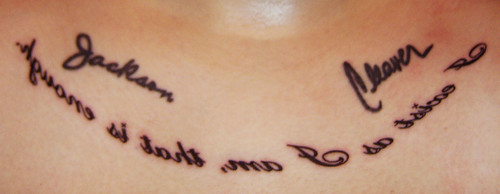
wwquotetattoo, originally uploaded by kawaface.
Like technology, the word text is difficult define as its meaning is altered depending upon context and form of communication. I found the definition of text provided by Florida State University, a good starting point to understanding the relationship between of text and technologies.
“Texts are material artifacts that take many different forms: cave paintings, tattoos, stone tablets, clay tablets, papyrus scrolls, manuscript books, musical scores, maps, printed books, engravings, newspapers, photographs, films, DVDs, computers. Every kind of text is produced by a special technology, but all those technologies share a simple purpose: they were designed to supplement the fragile human mind by providing a more durable artificial memory system. Those technologically preserved and transmitted memories are the foundation of all human culture”
(Emmerson et al., 2009, para. 1).
Prior to finding this definition I had never given much thought to tattoos as text. Emmerson et al. (2009) refer to technologies that produce text as “durable artificial memory system[s]”. Many people get tattoos as a permanent reminder of a special memory or person or a meaningful image, saying or word. Though I know many cultures use tattooing in traditional rituals, I had not considered the deeper implication of human skin as a vehicle for preserving and communicating information and memories. I choose the accompanying photo as it depicts tattoos of a person’s family names as well as a Walt Whitman quote – meaningful to the person whose skin it is preserved on.
References
Emmerson, R., Gontarski, S.E., Taylor, G., Walters, L., & Wiegand, W.A. (2009). Pathways to excellence: History of text technologies (HOTT) from cave paintings to personal computers. Retrieved September 13, 2009, from http://pathways.fsu.edu/faculty/hott/
September 14, 2009 No Comments
Text & Technology
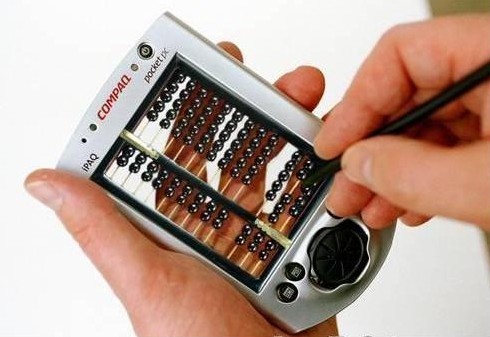
According to Chow, “The meaning of text involves writing and reading or, more appropriately, production and consumption. Production carries the intention of the author, while consumption is the process by which the reader makes meaning”.
A different approach to technology was explained by McLuhan as , “Technology is literally an extension of man, as the axe is an extension of the hand, the wheel of the foot. Most instruments are attempts to extend man’s physical capacity, a capacity shared with other animals. Communications technology, on the other hand, is an extension of thought, of consciousness, of man’s unique perceptual capacities. Thus communications media, broadly used to include all modes of symbolic representation, are literally extensions of mind”.
References
Chow, Kenny K. N. Operating Text and Transcending Machine: Toward an interdisciplinary Taxonomy of Media Works, LEONARDO, Vol. 41, No. 4, pp. 373-378, 2008.
Rosenthal, R. (ed), McLuhan Pro and Con, p 273, Baltimore: Penguin Books, 1968.
September 14, 2009 1 Comment
Library 2.0 searching for meaning
Hi everyone,
After reading through the WordPress entries today, I found that most of the passages I wanted to use had already been quoted. As a result, to find a short passage that gives meaning to the word text I decided to try my luck using the “Great Library 2.0”, i.e. Google Books, using the search terms “defining text”. I expected to find a deep, philosophical quote that would WOW you all. Well, I was indeed, surprised by the results. Of the top twenty hits, thirteen were in some way related to computer programming or desktop publishing software. I then tried a more refined search by looking for the exact phrase “defining text” (I did not use quotations the first time). This actually increased the number of computer related books to sixteen. “Define text” resulted in sixteen as IT results as well. Many searches later, I tried searching for “the origins of text”. Finally I started seeing some relevant results. However, there were still results for Unix and a text-mining computer application.
While the search results alone do not provide a passage that gives meaning to the word text, I think that the results shed light on the changing definition of the word text in the information age. The word text has become synonymous with the inventions of the digital age: text as a programming language, text as the basis for word processing, text as the foundation of the World Wide Web, etc. This was also stressed by O’Donnell and Engell when discussing the impacts that technology has had on education and on today’s youth, especially in regards to new language developing in text and e-mail. Technology not only redefines and revolutionizes text, it also reshapes the way interact with text and changes and reinvents the media through which we use it to communicate.
John
September 14, 2009 No Comments
Weaving tales
Words fascinate me and I love discovering where they come from. I had a little problem with text, as I remember my grandfather telling me of how in Ireland people were renowned for weaving tales and so weaving and woven were common words for me related to oral storytelling. I had never related them with the written word before, however on reflection it does make sense. Technology was more of a challenge. I had never considered the anthropological definition of technology as “a body of knowledge”. It seems so all encompassing. This would mean therefore that any new knowledge we have could be considered as technology and from there I must accept that all technology will cause changes whether we make them consciously or not.
Web Site
Definition of technology Dictionary.com retrieved on the 14th of September 2009 from
September 14, 2009 No Comments
Fabric a metaphor for text…
I have to admit that I was more interested at examining technology than text, but when I started reading the etymology of text from the Oxford English Dictionary I was immediately drawn in. My initial thoughts of simple written words were expanded by the latin root of textus – “that which is woven, web, texture” (Oxford English Dictionary). As a Home Ec teacher this caught my interest as I compared written work to that of woven fabric; both have depth, complexity and pose interest. Also, both text and fabric have wide ranging uses that are open for interpretation.
Sarah
September 14, 2009 No Comments
Meaning of Text
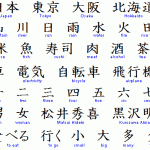
Text is any written language or series of symbols that contain meaning. The collection can be printed, engraved or painted as long as it is readable then it is considered as text. Hieroglyphs is an example of text. Electronic text is a version of the written word. Texting is the transfer of text.
The image above is a sample of Japanese texts or symbols used alone or in combination for communication. As time progresses, text and its meanings undergo transformations. Text is constantly being invented and introduced as humans progress and require extra texts to communicate effectively.
Carmen Chan.
September 14, 2009 No Comments
Text…
What is Text?
Posting by Caroline Faber
I was instantly drawn to the quote stating text is “essentially a vehicle for transmitting information and concepts.” The idea is simple and basic, opening up the doors to more complex notions. Text is a technology created to further enhance commmunication and from this, we can explore text further, in more complex capacities.
I was intrigued by the idea that text is necessarily comprised of 5 intrinsic values. Texts are:
- Real: they have properties independent of our interests in them and theories about them,
- Abstract: the objects which constitute texts are abstract, not material objects,
- Intentional: texts are, necessarily, the product of mental acts,
- Hierarchical: the structure of texts is fundamentally heirarchical,
- Linguistic: texts are linguistic objects; renditional features are not part of texts, and therefore not proper locations for textual meanings.”
…and now I anticipate challenging this to see if I can find examples of where this may not apply and underlying reasons for any exceptions.
Renear, A., McGann, J., and Hockey, S. (1999) What is Text? A debate on the philisophical and epistomological nature of text in the light of humanities computing research. University of Michigan. Accessed at: http://www.humanities.ualberta.ca/susan_hockey/ACHALLC99.htm
September 13, 2009 No Comments
The Power of the Written Word
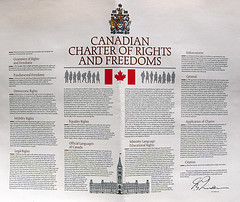
According to the Merriam-Webster’s Dictionary, the definition of text is: “the original words and form of a written or printed work (2) an edited or emended copy of an original work”( http://www.merriam-webster.com/dictionary/text).
Text is made up of Words. Words=Freedom. Freedom=Power.
I chose the picture of the Canadian Charter of Rights to indicate the power of text. Text can record history, put laws into effect, allow us freedoms that are documented for the next generation, and enables the recording of the passage of time. Text can describe in such a way as to ignite our imaginations and incite our passions. Putting on to paper the visions and aspirations that only lie in our minds is an amazing innovation.
September 13, 2009 3 Comments
Shedding light on the meaning of text
This is a passage from Richard Vella’s lecture originally presented in a fourth year composition class at the Sydney Conservatorium of Music, 1989. Entire lecture can be viewed at http://www.rainerlinz.net/NMA/repr/Music_theatre.html
Text does not mean words but rather the word text comes from the latin texere , to weave. Textum came to mean the tissue or web of a thing which is woven. The texture is then anything that is woven, the quality of the weave. In other words the text is the weaving together of all the elements into a shape, fabric, form. In music this came to mean texture. The text of a book or essay is the weaving together of all the various arguments via words. In film and opera the text is the weaving of the sonic and visual via their respective technologies. Texture is the fabric, text is the argument.
The setting of words to music is not simply text and music but rather the text is the overall weaving of the literary text with the musical texture. The text is the `meaning’ (argument) the composer wants to communicate via all these elements.
September 13, 2009 No Comments
My original take on text
Text defined
Text – In the strictest sense, I take this to mean the written word. It can be in any language that has a written component to it. Text can appear in just about any order (i.e. left to right, right to left, top to bottom, bottom to top). It can be presented in any number of ways (i.e. carved, painted, etched, engraved) using a variety of mediums (i.e. using paper, wood, stone, metal). Text is a form of expression – painters paint, photographers take pictures, directors make movies and writers write – they all have something they want to say.
Bruce
September 13, 2009 No Comments
Text as seen through Rebecca
Posted by Michael Haworth
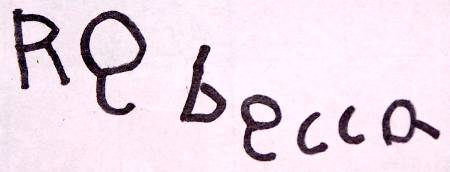
I think that a great example of text and what it represents is this image of my daughter Rebecca writing her name. Rebecca is five years old this year, just entering kindergarten, and is an emergent text user. She understands all of her letters, can write her name, and can copy words such as her current favourite “Hannah Montana”. Rebecca is beginning to unlock a world of communication through her developing ability to read and write and text. Text gives all those who have mastered it, a mode of communication with people across time and space in a wide variety of mediums such as print and electronic. Text provides a depth of communication and understanding between people that an image or another communication method may not. My daughter Rebecca is just starting her lifelong journey into the world of text, its immense power to communicate, and the incredible mosaic of uses. To see the opportunities that text is opening for her as she learns to read and write is simply amazing.
September 13, 2009 No Comments


